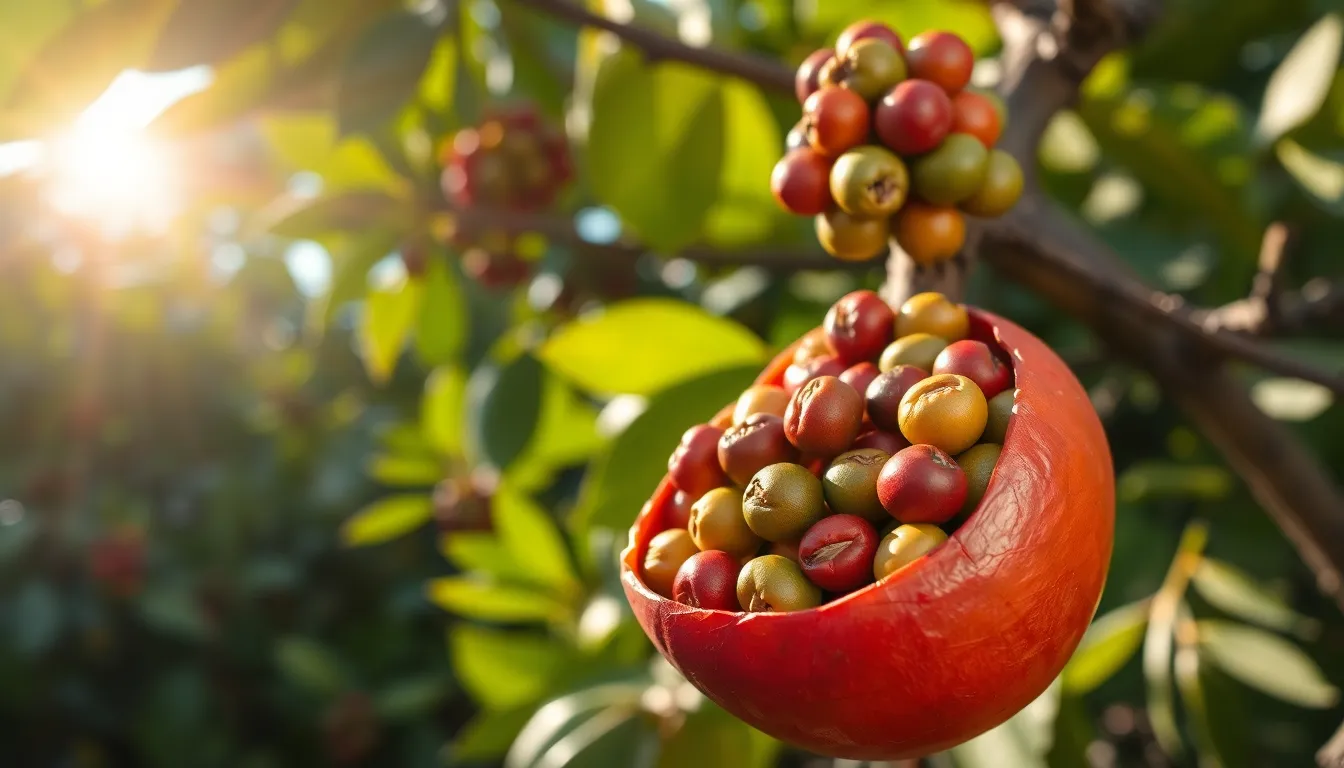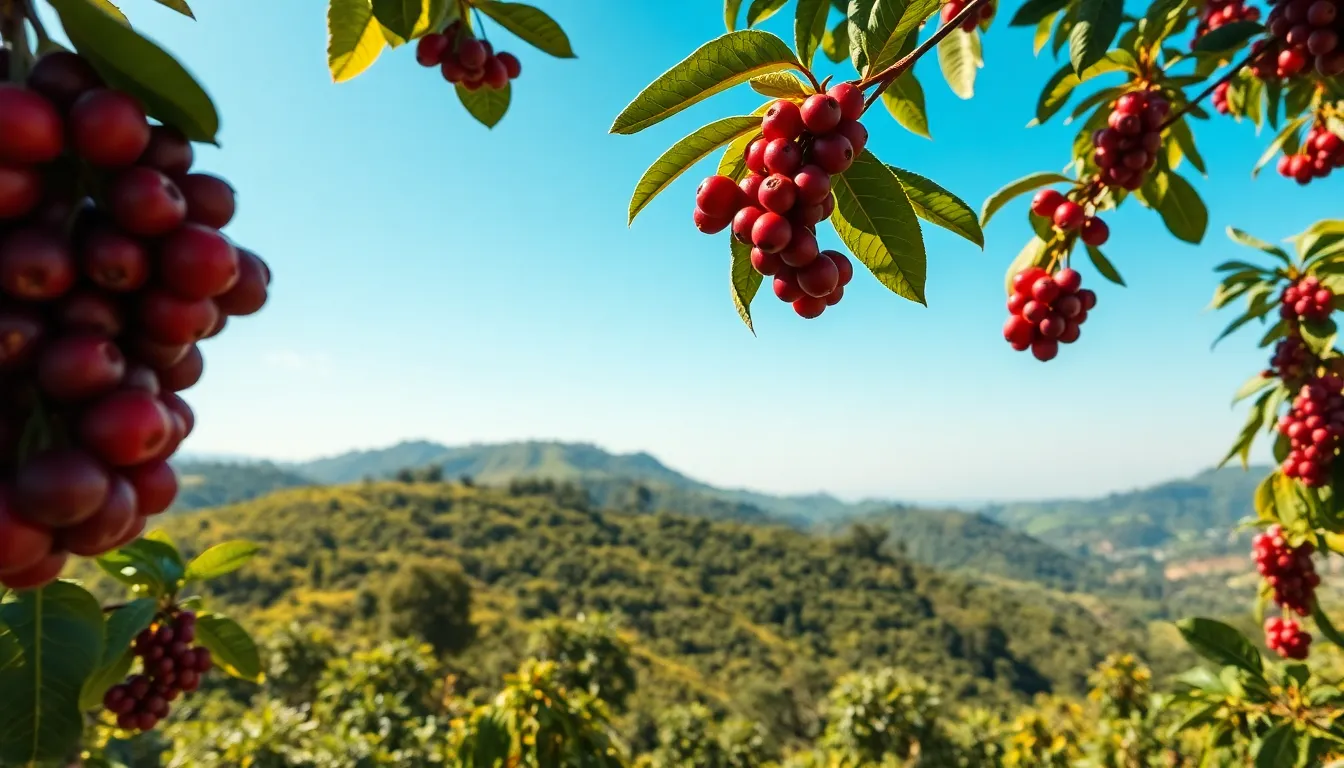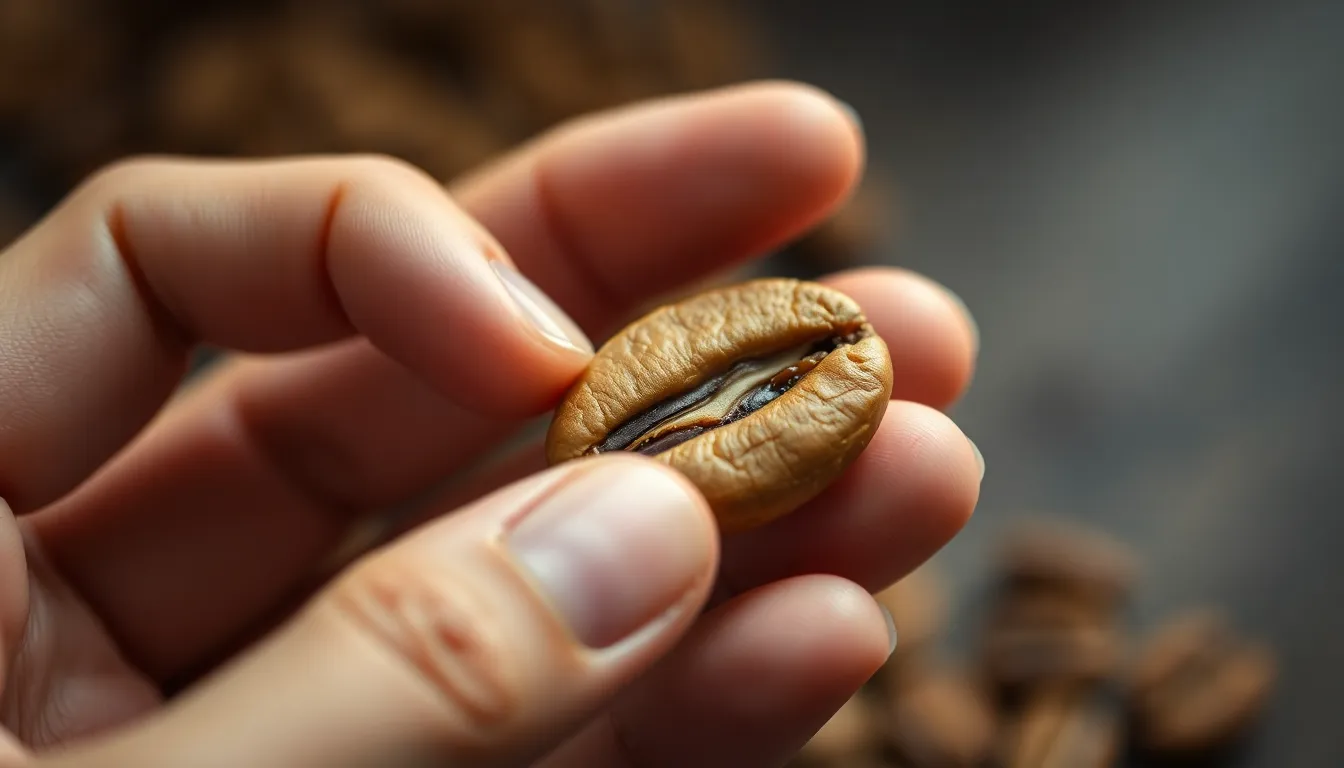Have you ever detected those delightful fruity notes in your morning coffee? That vibrant, sweet complexity isn’t just your imagination—it’s one of coffee’s most prized flavor characteristics that sophisticated drinkers actively seek out.
When coffee exhibits fruity flavors, it’s often a sign of high-quality beans and proper processing. These bright, tangy notes can range from berry and citrus to tropical fruits like mango or papaya. The origin, variety, growing conditions, and roasting method all influence whether your cup will burst with these desirable fruity profiles. Understanding what creates these flavors can help you select beans that’ll transform your daily brew from ordinary to extraordinary.
Understanding Fruity Taste Profiles in Coffee
Coffee’s fruity flavors aren’t just pleasant coincidences—they’re complex taste profiles developed through exact growing conditions, processing methods, and roasting techniques. These distinct fruity notes range from bright citrus to rich berries, creating an entire spectrum of flavor possibilities in your cup.
The Science Behind Fruity Flavors
Fruity flavors in coffee emerge from natural compounds called esters and aldehydes present in the coffee beans. These organic compounds interact with your taste buds to create recognizable fruit-like sensations. Coffee contains over 800 aromatic compounds, many of which contribute to these fruity characteristics. During the roasting process, chemical reactions like Maillard reactions and caramelization transform these compounds into the complex flavors you experience.
Light to medium roasts typically preserve more of these fruity compounds, while darker roasts tend to develop more caramelized, chocolatey notes. The pH level of coffee also affects how you perceive fruitiness—higher acidity coffees often exhibit more pronounced fruit characteristics.
Common Fruity Flavor Notes in Coffee
Coffees display a remarkable range of fruit flavors depending on their origin and processing:
- Berry notes: Blueberry, strawberry, and blackberry flavors are commonly found in Ethiopian coffees, particularly from the Yirgacheffe and Sidamo regions
- Citrus profiles: Lemon, orange, and grapefruit notes frequently appear in Central American coffees from Guatemala and Costa Rica
- Stone fruit characteristics: Peach, apricot, and plum flavors often emerge in Kenyan and some Colombian coffees
- Tropical fruit elements: Mango, pineapple, and papaya notes are hallmarks of many specialty coffees from Panama and Hawaii
- Apple and pear nuances: These crisp, clean fruit notes typically appear in washed coffees from South America
“I’ve had customers literally gasp when they first taste the intense blueberry notes in a natural Ethiopian Yirgacheffe,” Rikki Manny shared from behind the counter of his specialty coffee shop. “They can’t believe coffee can naturally taste so fruity without additives.”
How Processing Methods Affect Fruitiness
Coffee processing dramatically influences the development of fruity flavors:
Natural Processing: Allows coffee cherries to dry completely around the beans before removal. This method permits sugars from the fruit to impart stronger, sometimes wine-like fruity characteristics to the beans. Ethiopian naturals are famous for their intense berry notes achieved through this process.
Honey Processing: Removes the cherry skin but leaves varying amounts of fruit mucilage on the bean during drying. This middle-ground approach creates balanced fruity sweetness with medium acidity. Costa Rican honey-processed coffees often display delightful stone fruit and apple notes.
Washed Processing: Removes all fruit material before drying, resulting in cleaner, brighter flavors with pronounced acidity. Washed Kenyan coffees frequently showcase vibrant blackcurrant and grapefruit flavors through this method.
Experimental Fermentation: Modern processing innovations involve controlled fermentation to enhance exact fruit characteristics. Anaerobic fermentation can amplify tropical fruit notes, while extended fermentation may develop deeper berry profiles.
One coffee farmer Rikki visited in Colombia showed him how they monitored fermentation temperatures precisely to enhance the natural strawberry notes in their gesha variety beans.
The Science Behind Coffee’s Fruity Notes

Coffee’s fruity taste primarily comes from processing methods and chemical reactions that occur after harvest. These natural processes transform compounds in coffee beans, creating the distinctive fruit flavors that enhance your coffee experience.
Natural Processing and Fruit Flavors
Natural processing creates intensely fruity coffee by drying beans inside the coffee cherry. During this method, coffee beans absorb sugars and flavor compounds directly from the surrounding fruit flesh while drying in the sun. This prolonged contact with the fruit allows for extended fermentation, where yeasts and bacteria transform sugars into complex flavor molecules. The result is a cup with pronounced sweetness and distinctive fruity notes ranging from strawberry and blueberry to mango and wine-like qualities. Natural processing offers environmental benefits too, requiring significantly less water than other methods, making it popular in regions with limited rainfall. The extended drying time under the fruit skin enhances the beans’ natural sweetness while developing those bold, complex fruit characteristics that many specialty coffee enthusiasts seek.
Chemical Compounds That Create Fruity Tastes
The fruity flavors in your coffee come from exact chemical compounds formed during processing and fermentation. Esters, alcohols, and organic acids develop during the fermentation phase as microorganisms break down sugars in the coffee fruit. These compounds create the distinct berry, tropical, and wine-like aromas that make naturally processed coffees so distinctive. As coffee cherries dry, fruit sugars penetrate the bean, increasing both sweetness perception and fruity flavor intensity. The fermentation activity varies depending on processing method, with natural processing allowing for more extended microbial activity than washed processing. This difference explains why naturally processed coffees typically display more pronounced fruit flavors compared to washed coffees, which offer cleaner, brighter profiles with higher acidity but less fruity character. The exact combination of these chemical compounds creates the unique flavor fingerprint of each coffee, influenced by factors like origin, variety, and processing technique.
Top Coffee Regions Known for Fruity Flavors

Coffee’s distinct fruity profiles vary dramatically based on geography, altitude, and processing methods. Certain regions consistently produce beans with pronounced fruit-forward characteristics that coffee enthusiasts seek out for their complexity and vibrant flavors.
Ethiopian Fruit-Forward Varieties
Ethiopian coffee stands as the quintessential example of fruit-forward flavor profiles, originating from the birthplace of coffee itself. These beans thrive at high elevations and are often naturally processed, allowing the fruit to dry around the bean and impart intense fruity characteristics. Yirgacheffe, one of Ethiopia’s most celebrated growing regions, produces coffees with unmistakable blueberry notes, delicate stone fruit flavors, and jasmine-like floral aromas. The bright acidity in Ethiopian varieties complements their tea-like body, creating a complex cup that balances fruity sweetness with vibrant tanginess. Many specialty roasters highlight these beans for their distinctive berry-forward profile that can’t be replicated in other growing regions.
Kenyan Coffee and Fruity Profiles
Kenyan coffees deliver bold, juicy fruit characteristics thanks to the country’s high-altitude cultivation exceeding 1,500 meters. These beans feature pronounced blackcurrant and grapefruit notes, often described as wine-like in their complexity and brightness. The rich volcanic soils contribute to Kenya’s signature intense blackberry flavors and bright acidity that cuts through the full-bodied richness. Coffee connoisseurs particularly value Kenyan varieties for their remarkable clarity of flavor and the way their fruity notes shine through even in espresso preparations, making them a staple in specialty coffee shops looking to showcase distinctive regional characteristics.
Central American Fruity Coffee Profiles
Central American coffees balance fruity notes with complementary flavors, creating approachable yet complex cups. Costa Rican beans exhibit citrusy brightness alongside tropical and stone fruit hints, all grounded in earthy, herbal undertones. Guatemalan coffees showcase sweet fruit characteristics harmonized with chocolate and nutty foundations—a product of the region’s mineral-rich volcanic terrain. Panama, particularly famous for its Geisha varietal, produces some of the industry’s most sought-after fruity coffees with delicate citrus notes and exceptional sweetness. The mountainous growing conditions throughout Central America contribute significantly to these balanced flavor profiles, where the fruit notes integrate seamlessly with the region’s characteristic chocolate and nut flavors rather than dominating the cup. Coffee from this region provides an excellent entry point for those beginning to explore fruit-forward varieties.
How Roasting Affects Fruity Taste in Coffee

Roasting transforms the inherent flavor compounds in green coffee beans through complex chemical reactions that either enhance or diminish fruity notes. The roasting process activates and alters these compounds through Maillard reactions and caramelization, directly impacting how pronounced the fruit flavors will be in your final cup.
Light vs. Dark Roasts for Fruit Notes
Light roasts preserve more of coffee’s natural fruity characteristics because they’re exposed to heat for shorter periods at lower temperatures. These milder roasting conditions maintain the bean’s natural acidity and protect the volatile aromatic compounds responsible for berry-like, floral, and citrus fruit notes. Coffee varieties like Excelsa display naturally tart fruitiness that shines brightest when lightly roasted, allowing their distinctive flavor profiles to take center stage.
Dark roasts significantly reduce fruity flavors as the extended roasting time breaks down the acidic and fruity compounds. The prolonged heat exposure transforms these delicate notes into more bitter, smoky, and caramelized flavors. Most dark-roasted coffees exhibit muted or completely absent fruit notes, replaced instead by deep chocolate, nutty, or toasted flavors that dominate the profile.
The Role of Roast Temperature and Timing
Temperature control plays a crucial role in developing or preserving fruity flavors in coffee. Lower roasting temperatures between 300-356°F (150-180°C) create the perfect conditions for Maillard reactions and caramelization without destroying the delicate fruit aromatics. Exceeding these temperature ranges risks burning off the volatile compounds that create those desirable fruit notes.
Timing affects fruit flavor development just as significantly as temperature. Quicker roasting preserves more bright fruit flavors by limiting heat exposure and slowing the degradation of organic acids and fruit compounds. Slower roasting methods reduce acidity, which might be preferable for espresso blends where less brightness balances better with the concentrated brewing method.
Roast curve management offers roasters precise control over fruit flavor development. By adjusting the rate of temperature rise and carefully monitoring the development phase, master roasters enhance fruitiness and sweetness while achieving the perfect balance of acidity and body. These subtle adjustments make the difference between a coffee with hint of fruit and one with pronounced, vibrant fruit character.
The interaction between roast temperature, timing, and coffee variety determines the final expression of fruit notes in your cup. Light roasting with shorter times and moderate temperatures brings out the brightest, most complex fruit characteristics, while darker roasting creates richer profiles where other flavor notes take precedence over fruitiness.
Brewing Methods That Enhance Fruity Flavors

Different brewing techniques significantly impact how fruity flavors express themselves in your coffee cup. The extraction method you choose can either highlight or diminish these delicate flavor notes, making your brewing approach just as important as bean selection.
Pour-Over Techniques for Fruit-Forward Cups
Pour-over methods excel at showcasing the bright, fruity characteristics in coffee beans. Chemex and Hario V60 brewers offer exceptional clarity and brightness, accentuating berry-like notes, floral undertones, and vibrant fruit flavors through precise control of water flow and extraction time. These methods particularly enhance the natural acidity and fruit-forward profiles found in light-roasted, single-origin coffees from Ethiopia and Kenya.
To maximize fruity flavors with pour-over brewing:
- Select freshly roasted beans with known fruity profiles, particularly natural-processed Ethiopian or Kenyan varieties
- Grind beans to medium coarseness just before brewing
- Heat water between 195°F and 205°F for optimal extraction
- Pre-rinse your paper filter to remove any papery taste
- Distribute grounds evenly in the filter for balanced extraction
- Maintain a consistent pour rate throughout the brewing process
- Watch your brew time carefully to avoid over-extraction
These techniques help highlight the distinctive berry, citrus, and tropical fruit notes defined in the Specialty Coffee Association’s Flavor Wheel, giving you access to the full spectrum of fruity characteristics your beans offer.
Cold Brew and Its Effect on Fruity Notes
Cold brew produces a dramatically different expression of fruit flavors compared to hot brewing methods. The prolonged, cooler extraction process tends to mute higher acidity and complex fruity notes that typically shine in hot brewing. This results in a smoother, sweeter cup with subdued fruitiness as the extended steeping time blends flavors together.
The lower temperature extraction of cold brew often dulls the crisp, bright fruit flavors that emerge during hot extraction. While this creates an exceptionally smooth and easy-drinking coffee, it’s not the ideal method for highlighting delicate berry notes or citrus highlights. Cold brew works better for bringing out chocolate, nutty, and caramel notes rather than the vibrant fruit characteristics found in specialty beans from regions like Ethiopia.
For those seeking to experience the full range of fruity flavors coffee can offer, pour-over methods provide the clearest expression, while cold brew offers a more subtle, blended approach to fruit notes.
Pairing Fruity Coffee With Food

Fruity coffees create exceptional culinary experiences when matched with the right foods that enhance their vibrant flavor profiles. These bright, complex coffees offer unique pairing opportunities that can elevate both the coffee and food components. The natural acidity and sweetness in fruity coffees make them versatile companions for various dishes throughout the day.
Breakfast Pairings
Fruit-forward coffees shine alongside morning foods that complement their lively character. Pastries containing berries or citrus elements naturally extend the flavor journey begun in your cup. Yogurt topped with fresh berries creates a harmonious balance, with the creamy texture softening coffee’s acidity while the fruit notes mirror those in your brew. Citrus-infused breakfast dishes, such as orange-scented French toast or lemon pancakes, form perfect partnerships with coffees displaying similar bright notes.
Dessert Companions
Light desserts provide ideal backdrops for fruity coffees without overwhelming their nuanced flavors. Berry tarts, fruit compotes, and citrus-based cakes bring out parallel notes in Ethiopian or Kenyan coffees. Angel food cake, pavlova, or fruit-based sorbets offer subtle sweetness that allows the coffee’s complexity to remain center stage. The contrasting temperatures and complementary flavors create a multidimensional tasting experience that highlights both components.
Cheese Selections
Soft, mild cheeses balance fruity coffee’s natural acidity while providing textural contrast. Goat cheese, with its tangy profile, pairs beautifully with coffees displaying berry or citrus characteristics. Creamy ricotta drizzled with honey creates a sweet counterpoint to bright coffee notes. These pairings work particularly well with naturally processed coffees from Ethiopia or honey-processed varieties from Central America, where fruit flavors are most pronounced.
Fresh Fruit Accompaniments
Serving fresh fruits alongside fruity coffees reinforces similar flavor profiles and creates sensory harmony. Berries served with Ethiopian coffees highlight the blueberry and raspberry notes often found in beans from Yirgacheffe and Sidamo regions. Stone fruits like peaches and apricots complement coffees with similar sweet profiles. Citrus segments pair beautifully with high-altitude coffees that display pronounced acidity and brightness, such as those from Ethiopia’s Guji region.
These thoughtful pairings maximize the complex fruity characteristics in specialty coffees, creating memorable tasting experiences that showcase the coffee’s natural sweetness and acidity. The contrast and complementary nature of these food pairings enhance the coffee’s distinctive fruit notes while providing delightful texture and flavor combinations.
Conclusion
Fruity flavors in coffee reveal a intriguing area of complexity that goes well beyond your morning caffeine fix. By understanding the impact of origin regions processing methods roasting techniques and brewing approaches you’ll be better equipped to find coffees that match your taste preferences.
Whether you’re drawn to the blueberry notes of Ethiopian Yirgacheffe or the bright citrus profiles of Central American beans your appreciation for coffee’s fruity characteristics can transform your daily ritual into an extraordinary sensory experience.
Next time you’re selecting beans look for those light to medium roasts from renowned fruity regions and pair them thoughtfully with complementary foods. Your coffee journey doesn’t end here—it’s just beginning to get more flavorful.
Frequently Asked Questions
What causes fruity flavors in coffee?
Fruity flavors in coffee come from natural compounds like esters and aldehydes present in the beans. These flavors are influenced by the coffee’s origin, variety, growing conditions, and processing methods. High-quality beans grown at higher elevations typically develop more complex fruit notes. The way coffee is processed after harvest also significantly impacts fruity characteristics, with natural processing generally producing more pronounced fruit flavors.
Which coffee regions are known for fruity coffees?
Ethiopia leads the way with its distinctive blueberry and floral notes, especially in Yirgacheffe beans. Kenya is renowned for bold blackcurrant and grapefruit flavors thanks to volcanic soils and high-altitude cultivation. Central American countries like Costa Rica and Guatemala offer balanced fruity profiles with complementary flavors. Panama and Hawaii produce specialty coffees with tropical fruit elements like mango and pineapple.
How does processing affect fruity flavors in coffee?
Processing methods dramatically influence fruity flavors. Natural processing (drying beans inside the fruit) produces intense berry notes as beans absorb sugars from the cherry. Honey processing creates balanced sweetness and fruit flavors. Washed processing yields cleaner, brighter flavors with higher acidity but less fruit intensity. Experimental fermentation techniques can amplify specific fruit notes through controlled microbial activity.
Does roast level impact fruity flavors?
Absolutely. Light to medium roasts preserve more fruity notes because shorter heat exposure maintains the beans’ natural compounds. As roasting darkens, fruity flavors diminish and are replaced by caramelized, bitter notes. Roasters can enhance fruity profiles by using lower temperatures, quicker roasting times, and carefully managing the roast curve to control how fruit flavors develop in the final cup.
Which brewing methods best showcase fruity coffees?
Pour-over methods like Chemex and Hario V60 excel at highlighting fruity characteristics because they provide clarity and control over extraction. For best results, use freshly roasted beans, proper grinding (medium-fine), and maintain consistent pour rates. Cold brew tends to mute fruity notes, emphasizing chocolate and nutty flavors instead. AeroPress and siphon methods can also accentuate fruit flavors with proper technique.
What foods pair well with fruity coffees?
Breakfast pastries with berries or citrus complement fruity coffees beautifully. Light desserts like berry tarts or citrus cakes enhance similar flavor notes without overwhelming the coffee. Soft cheeses such as goat cheese and ricotta balance the coffee’s acidity. Fresh fruits that mirror the coffee’s flavor profile create a harmonious pairing. Avoid heavy, creamy desserts that might mask the coffee’s nuanced fruit characteristics.
Can fruity flavors indicate coffee quality?
Often, yes. Distinctive fruity notes typically indicate high-quality beans, proper growing conditions, and careful processing. They’re commonly associated with specialty coffee grades and reflect the coffee’s terroir and varietal characteristics. However, quality coffee comes in many flavor profiles beyond fruit notes. The clarity and complexity of flavors, regardless of their specific nature, are better indicators of overall quality.
How can I identify specific fruit flavors in coffee?
Develop your palate through mindful tasting. Try cupping different coffees side by side to compare flavors. Use a flavor wheel as a reference point for identifying specific notes. Taste actual fruits alongside coffee to recognize similarities. Take notes on different coffees you try, and consider participating in tasting events or classes. Remember that palate development takes time and practice.


























